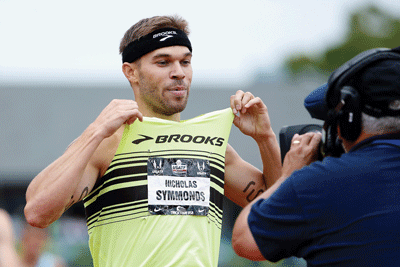Athletes’ rights took center stage again this month when U.S. runner Nick Symmonds forfeited his place in the world championships to protest what he calls “bullying” by USA Track & Field and its uniform sponsor Nike.
Don’t count on it being the last time. Experts expect Symmonds to eventually be just one of many skirmishes on the topic heading into the 2016 Olympics as athletes demand a bigger share of the Games’ expanding business opportunities.
 |
Nick Symmonds bypassed the IAAF World Championships to protest a requirement by USA Track & Field that he wear Nike’s Team USA gear.
Photo by: GETTY IMAGES
|
As the Symmonds-USATF feud illustrates, rising sponsorship fees across all sports have caused official partners such as Nike to be more demanding about maximizing their rights, while also causing athletes to be more aggressive in carving out what ground they can control and protecting their own sponsors.
Meanwhile, social media has grown more powerful since Olympians first used Twitter to build public support for their complaints during the 2012 Games in London, allowing them to build a brand independent of their sport’s institutions.
“I think we’re at a flashpoint for athletes’ rights, and particularly among Olympians as we look forward to the next Olympic Games,” said Sathya Gosselin, a partner at Washington, D.C., law firm Hausfeld who represented the plaintiffs in the O’Bannon v. NCAA case.
Symmonds objected to a USATF contract requiring him to wear Nike-branded Team USA gear at the IAAF World Championships, which begin Saturday, because it didn’t define “team events,” leaving a gray area for the team to expand Nike’s exclusivity at the expense of his own sponsor, Brooks Running. As it became clear that the USATF wouldn’t yield, the two-time Olympian aggressively lobbied his case on Twitter, retweeting sympathetic articles, posting his own arguments and building a network of fans who took his side. “I don’t know how I could have fought this fight without social media,” Symmonds said.
If Symmonds and his sympathizers successfully win limits on those rules at the USATF’s annual meeting in December, as he hopes, it would be the second concession on athletes’ rights made by a major Olympic sports institution this year. In June, the U.S. Olympic Committee changed some rules around Rule 40, which generally bans non-rights holders from running advertising with Olympian endorsers during the Games.
Rule 40 and Symmonds’ complaints fall under the same category that’s increasingly impossible to ignore in the modern digital media age, said Octagon agent Peter Carlisle, whose client Michael Phelps found himself at the center of a Rule 40 controversy during both the 2010 Vancouver Games and the 2012 London Games.
“Social media provides a platform for opinions to be expressed, for them to be galvanized, and for people to become more educated on this important issue,” Carlisle said, “so it’s harder for the momentum of the current system to just roll on without needed change.”
Nike and USATF struck a 24-year deal worth an estimated $500 million last year, a deal that cements Nike as by far the governing body’s single largest revenue stream through 2040. It’s a windfall to the sport, but others have raised questions about the outsized influence it offers. Competitors who can’t afford mega sponsorships must decide if it’s still worth marketing in a sport dominated by their larger rivals, said Steve McKelvey, a sports management professor at the University of Massachusetts, Amherst, who studies unofficial marketing tactics.
At least in this case, the issue of athletes’ rights turned out to be a huge winner for Brooks’ efforts.
“If I was Brooks I’d be playing this up like crazy,” McKelvey said. Symmonds managed to get more publicity for his sponsor than a race ever could have, McKelvey noted. “Who knows whether he did this to get them more attention, but that was the end result,” he said.




